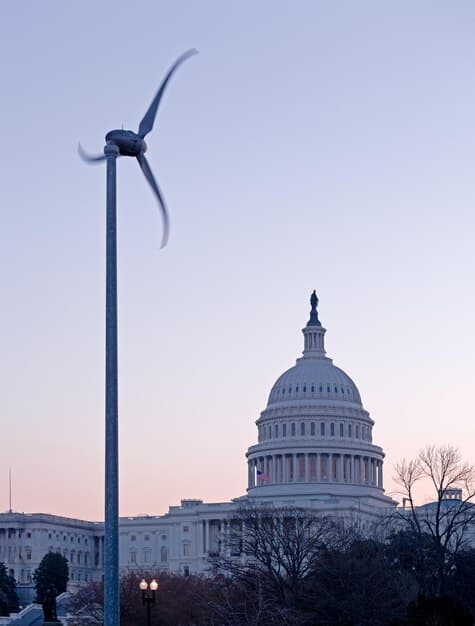US Climate Legislation 2025: What’s Next for Climate Action?

In 2025, the US Congress is expected to consider new climate change legislation focusing on renewable energy incentives, carbon capture technologies, and infrastructure resilience to combat climate change effects, with potential bipartisan support and significant economic implications.
As the year 2025 approaches, discussions are intensifying around potential legislative actions to address climate change in the United States. This article aims to explore what new climate change legislation is being considered by the US Congress in 2025, examining the key proposals, potential roadblocks, and the overall impact on the nation’s efforts to combat climate change.
Potential Focus Areas for Climate Legislation
The upcoming climate change legislation in the US Congress is likely to address several critical areas. These include incentivizing renewable energy sources, investing in carbon capture technologies, and enhancing infrastructure resilience to cope with the impacts of climate change. Understanding these potential focus areas is crucial for anticipating the scope and direction of the legislation.
Renewable Energy Incentives
One key aspect of climate legislation often involves incentives for renewable energy. This can include tax credits, grants, and loan programs aimed at boosting the production and adoption of solar, wind, and other renewable energy sources.
Carbon Capture Technologies
Another area of focus is carbon capture, utilization, and storage (CCUS) technologies. These technologies aim to capture carbon dioxide emissions from industrial sources and either store them underground or utilize them in various applications.

Several factors may influence the approach to carbon capture technologies:
- Government funding for research and development of CCUS.
- Tax incentives for companies investing in carbon capture projects.
- Regulations promoting the deployment of carbon capture in key industries.
In summary, the primary focus areas for climate legislation revolve around promoting green technologies and incentivizing carbon mitigation.
Bipartisan Support and Potential Challenges
Achieving significant progress on climate change legislation requires bipartisan support. While there is growing recognition of the urgency to address climate change, securing agreement across party lines can be challenging. Several factors influence the likelihood of bipartisan cooperation and the potential roadblocks that may arise.
Areas of Potential Agreement
Despite partisan divisions, there are areas where bipartisan agreement may be possible. These often include investments in renewable energy technologies and infrastructure projects that can create jobs and stimulate economic growth.
Potential Roadblocks
Several factors could impede bipartisan cooperation on climate legislation. These include disagreements over the appropriate level of government intervention, the role of fossil fuels in the energy transition, and the potential economic impacts of climate policies.
Achieving bipartisan support will likely require:
- Focusing on areas of common ground, such as investments in clean energy technologies.
- Addressing concerns about the economic impacts of climate policies.
- Building trust and fostering collaboration between lawmakers from different parties.
In conclusion, bipartisan support is a requisite, and there are certain areas of agreement that both parties have demonstrated.
The Role of International Agreements
International agreements, such as the Paris Agreement, play a significant role in shaping the context for domestic climate legislation. The commitments made by the United States under these agreements can influence the scope and ambition of climate policies at the national level. To fully understand domestic incentives, it’s important to explore the connection with international agreements.
US Commitments Under the Paris Agreement
The Paris Agreement establishes a framework for global cooperation to reduce greenhouse gas emissions and limit global warming. As a signatory to the agreement, the United States has pledged to achieve specific emissions reduction targets.
Impact on Domestic Legislation
The US commitments under the Paris Agreement can influence the design and implementation of domestic climate legislation. For example, the need to meet emissions reduction targets may drive the adoption of policies that incentivize renewable energy and discourage fossil fuel consumption.

The Current State of International Climate Cooperation
The current state of international climate cooperation may involve:
- Ongoing negotiations to strengthen global climate commitments.
- Efforts to mobilize financial support for developing countries to address climate change.
- Collaboration on technology development and deployment.
Essentially, the role of International Agreements plays an important role in domestic climate legislation.
Economic Implications of New Climate Laws
New climate change legislation can have significant economic implications for various sectors of the US economy. These impacts can range from job creation in the renewable energy sector to potential costs for industries that rely heavily on fossil fuels. It’s critical to analyze the economic implications of new climate laws, as their implementation impacts many facets of daily life.
Job Creation in Clean Energy Sectors
Investments in renewable energy and clean technologies can create new jobs in manufacturing, installation, and maintenance. These jobs can help to offset potential job losses in declining industries, such as coal mining.
Costs for Fossil Fuel Industries
Climate policies that discourage fossil fuel consumption, such as carbon taxes or stricter emissions standards, can impose costs on industries that rely heavily on coal, oil, and natural gas. These costs may lead to job losses and reduced economic activity in affected regions.
Analyzing the economic implications is crucial for:
- Identifying potential winners and losers from climate policies.
- Designing policies that minimize negative economic impacts.
- Ensuring that the benefits of climate action are shared broadly.
The economic implications of new climate laws are far-reaching with potential benefits and disadvantages.
Industry Perspectives on Climate Legislation
Different industries have varying perspectives on climate legislation, reflecting their unique interests and concerns. Understanding these perspectives is essential for assessing the political feasibility of different climate policies and anticipating potential industry lobbying efforts.
Renewable Energy Industry
The renewable energy industry generally supports climate legislation that promotes the adoption of clean energy technologies. This can include tax credits, renewable energy standards, and other policy measures that create demand for renewable energy.
Fossil Fuel Industry
The fossil fuel industry often opposes climate legislation that would increase costs for fossil fuel producers or consumers. This can include carbon taxes, stricter emissions standards, and policies that restrict access to fossil fuel resources.
Different industries can influence these laws:
- Lobbying efforts to shape climate policies in their favor.
- Public relations campaigns to influence public opinion about climate change and climate policy.
- Legal challenges to regulations that they view as harmful to their interests.
In summary, industries are key players with influence in climate legislation.
Technological Innovations and Climate Policy
Technological innovations play a crucial role in enabling more ambitious and cost-effective climate policies. Breakthroughs in areas such as renewable energy, energy storage, and carbon capture can help to accelerate the transition to a low-carbon economy. In this context, technological innovations and policies go hand-in-hand.
Advances in Renewable Energy Technologies
Advances in solar, wind, and other renewable energy technologies are driving down the cost of clean energy and making it more competitive with fossil fuels. These technological improvements are essential for achieving deep cuts in greenhouse gas emissions.
Energy Storage Solutions
Energy storage technologies, such as batteries and pumped hydro storage, can help to address the intermittency of renewable energy sources and ensure a reliable electricity supply. These technologies are becoming increasingly important as renewable energy sources account for a larger share of electricity generation.
Promoting technological innovation requires:
- Government funding for research and development.
- Incentives for private sector investment in clean technologies.
- Regulations that create a level playing field for clean energy technologies.
To summarise, technological innovations are key for affordable climate policy.
Public Opinion and Political Feasibility
Public opinion plays a significant role in shaping the political feasibility of climate legislation. Strong public support for climate action can create political momentum for lawmakers to enact ambitious climate policies. It’s therefore important to assess how public opinion and politics interact.
Shifting Attitudes Towards Climate Change
Public attitudes towards climate change have been shifting in recent years, with a growing number of Americans expressing concern about the issue and supporting government action to address it. This shift in public opinion reflects growing awareness of the impacts of climate change and a desire for political leadership on the issue.
Political Challenges
Despite growing public support for climate action, political challenges remain. Partisan divisions, regional differences, and the influence of special interests can all complicate efforts to enact comprehensive climate legislation.
Fostering public support is accomplished with:
- Education and outreach efforts to raise awareness about climate change and its impacts.
- Advocacy campaigns to mobilize public support for climate action.
- Political leadership to build consensus and overcome opposition to climate policies.
Public opinion is essential for building consensus around climate change action.
| Key Point | Brief Description |
|---|---|
| 🌱 Renewable Incentives | Focus on tax credits and grants to boost solar and wind energy. |
| 🏭 Carbon Capture Tech | Investment in technologies to capture and store CO2 emissions. |
| 🤝 Bipartisan Support | Potential agreement on clean energy and infrastructure projects. |
| 🌍 International Agreements | Commitments under the Paris Agreement influence US climate policies. |
Frequently Asked Questions
▼
The primary goals include reducing greenhouse gas emissions, promoting renewable energy sources, and enhancing infrastructure resilience to the impacts of climate change. The overall aim is a sustainable, low-carbon economy.
▼
The legislation could affect energy costs, job opportunities, and the overall health and environment of communities. Incentives for electric vehicles and home energy efficiency upgrades are also possible.
▼
Renewable energy is likely to play a central role, with incentives such as tax credits and grants aimed at increasing the production and adoption of solar, wind, and other clean energy sources.
▼
Potential challenges include partisan divisions, disagreements over the role of fossil fuels, and concerns about the economic impacts of climate policies. Strong lobbying efforts may be possible by opposed sides.
▼
International agreements, such as the Paris Agreement, influence the scope and ambition of domestic climate policies. Commitments made by the US under these agreements can drive the adoption of climate legislation.
Conclusion
As the US Congress prepares to consider new climate change legislation in 2025, the focus will likely be on renewable energy incentives, carbon capture technologies, and infrastructure resilience. Achieving bipartisan support and addressing economic implications will be vital for enacting effective and impactful climate policies, guided by international agreements and shaped by technological innovation and public opinion





